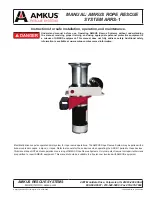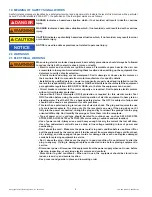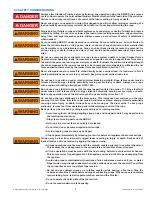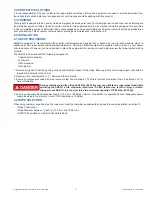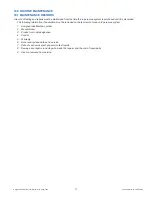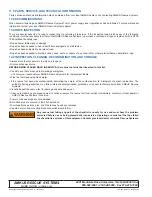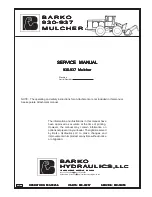
©Copyright Amkus Rescue Systems, Inc. 2018-2020
LAA-002 March 10, 2020 Rev02
5
2.2 SAFETY CONSIDERATIONS
DANGER
Always attach tandem Prusiks before performing any operation using the AMKUS rope rescue
system. Never operate the hoist without tandem Prusiks attached to the load side of the main line.
Failure to do so may result in loss of control of the load resulting in injury or death.
DANGER
Never allow rope on capstan to overlap. Overlapped rope will not allow raising or lowering of a
load potentially causing injury or death. Be mindful not to overlap while tailing the rope.
WARNING
Single points of failure in rope and hoist systems can cause injury or death of victims and rescue
workers by falling. Do not raise or lower a live load without setting appropriate edge protection,
belay lines, and separate anchor points. Always assure a second level of safety is established
when needed.
WARNING
Avoid operating ARRS-1 under hazardous conditions. Some conditions are, but not limited to
areas that contain liquids, solids, gases, mists, or vapors of any chemical or other material that
are
fl
ammable or can deteriorate rope. Areas such as these greatly increase the potential for
serious injury or death. Always be aware of and avoid environmental hazards at rope rescue
sites.
WARNING
Do not use components or supports in a rope rescue system unable to support impact forces
from maximum operating loads. Components or supports not able to support these forces may
fail and strike personnel causing severe injury or death. Evaluate the minimum breaking strength
of each component in the rope rescue system. Each component must be able to withstand the net
force applied to themselves by the impact force example listed in section 7.1.3.
WARNING
Never allow personnel or yourself to stand directly under a vertical load. If a load were to fall, it
could potentially cause severe injury or death. Keep area under vertical load clear.
WARNING
Do not use a rope with an under rated minimum breaking strength. Rope failure under tension
releases stored energy violently, potentially causing severe injury or death. Always use a rope
with a minimum breaking strength per NFPA 1983..
WARNING
Do not use a rope that fails any part of the rope inspection listed in section 11.1. Rope that fails
under tension will release stored energy violently potentially causing severe injury or death.
Before any operation check the entire length of rope according to section 11.1.
WARNING
Do not keep the rope stationary as the drum spins. This increases heat and wear on the rope
causing it to fail. Rope that fails under tension will release stored energy violently potentially
causing severe injury or death. Always keep rope moving as the drum spins. To keep rope
stationary, remove foot from operation pedal while retaining control of the rope.
WARNING
Body parts can be crushed by entanglement with rope or rotating capstan.
• Avoid loose gloves, clothing, dangling straps, hair, and body parts which may be pulled into
the rotating capstan drum.
.• Stay clear of moving parts on the ARRS-1.
• Hold rope in a manner that can quickly be released
• Do not stand on or become wrapped in tailed rope.
• Avoid wrapping rope around any body part.
• Stop capstan immediately by releasing foot switch before entanglement becomes serious.
WARNING
Tension may be lost from incorrectly rigged ropes resulting in injury or death. Reduce risk of
inadvertent loss of rope tension by rigging the rope correctly;
• All rope operations must be made with the motor & capstan oriented in a vertical alignment.
This assures the rope approach to the swivel plate and lead block from all angles.
• All rope operations must be made with the line running between both lead block sheaves.
This assure correct rope alignment on the capstan and avoids risk of rope unwrapping from
the capstan.
• Avoid using rope contaminated with sections of slick substances such as oil, ice, or water.
Rope tension may change suddenly when slick sections pass over the capstan. Consistent
rope properties assure consistent rope tension.
• Do not add or subtract wraps on a rotating capstan while bearing a live load. Stop the
capstan and lock the Prusiks before adding or subtracting wraps. When wraps are complete
resume tailing force, restart capstan rotation, and tend the Prusiks.
• Do not operate the hoist without the foot switch.
• Do not exceed maximum rated capacity.

